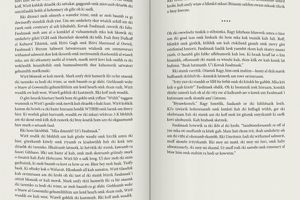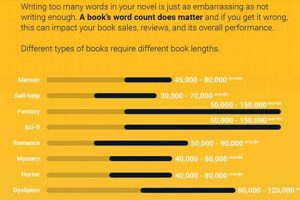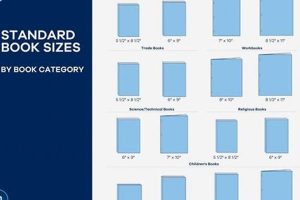The dimensions of a leaf within a bound volume are subject to considerable variation. These measurements are influenced by factors such as genre, intended audience, and printing cost considerations. For instance, a mass-market paperback novel will typically exhibit smaller page dimensions than a hardcover art book.
Standardizing formats offers advantages in printing efficiency, distribution logistics, and reader expectations. Historical developments in papermaking and printing technology have significantly shaped common paper sizes. The adoption of particular dimensions impacts the overall aesthetic appeal and portability of the finished product. Variations can also be indicative of specific publishing traditions or target markets.
The following sections will explore prevalent dimensions in different book categories, focusing on common North American and international standards, and will further examine the rationale behind the selection of specific page formats and their impacts on production and consumer experience.
Guidance on Book Page Dimensions
Considerations related to leaf dimensions play a crucial role in the design and production of bound volumes. Optimal selections directly impact readability, manufacturing costs, and overall market appeal.
Tip 1: Genre Appropriateness: Select dimensions commensurate with the subject matter. Reference books and textbooks frequently benefit from larger page formats, facilitating the inclusion of detailed diagrams and extensive textual information.
Tip 2: Target Audience: Age and visual acuity of the intended readership warrant consideration. Childrens books often utilize larger fonts and generous margins, necessitating larger dimensions.
Tip 3: Printing Efficiency: Minimize waste by choosing dimensions that align with standard paper sizes. This reduces trimming and optimizes the yield from each sheet of paper during the printing process.
Tip 4: Binding Method: The intended binding style can influence the final dimensions. Case binding (hardcover) often allows for greater flexibility, while perfect binding (paperback) may impose certain limitations.
Tip 5: Portability Considerations: If convenient transport is a priority, smaller formats, such as those found in mass-market paperbacks or pocket guides, are preferable.
Tip 6: Margin Allocation: Adequate margins are crucial for readability and aesthetic appeal. Insufficient margins can result in text that appears cramped or is difficult to read, particularly near the spine.
Tip 7: Image Integration: The presence of illustrations, photographs, or other visual elements necessitates careful planning. Ensure that chosen dimensions adequately accommodate these elements without compromising text readability.
Careful consideration of these elements related to leaf dimensions will contribute to a well-designed, cost-effective, and commercially successful book.
The following sections delve into specific formats and standards utilized within the publishing industry.
1. Trim Size
Trim size represents the final dimensions of a leaf after the printing and binding process. As such, it directly defines what the completed dimensions are. It is a fundamental component in determining the dimensions, dictating the physical footprint of the text and any accompanying illustrations. A book’s classification, such as a novel, textbook, or art book, often determines the trim size. For example, a mass-market paperback generally adheres to a smaller trim size for portability, while a coffee table book utilizes a larger trim size to showcase visual content.
The selection of a specific trim size has cascading effects on various stages of the book production process. It influences paper usage, imposition schemes, and printing press configurations. Publishers must carefully consider standard trim sizes to minimize paper waste and reduce overall printing costs. Furthermore, the trim size dictates the size of the cover, dust jacket, and shipping cartons. These considerations impact the efficiency of distribution and storage logistics. Variations from standard trim sizes can lead to increased costs and logistical challenges.
Therefore, understanding trim size is critical to managing cost and optimizing design. It serves as a foundational element, influencing decisions related to design, printing, binding, and distribution. Improper consideration of trim size can lead to inefficiencies and increased expenses throughout the production cycle. Its direct impact on the physical dimensions of the finished product underscores its importance in achieving both functional and aesthetic objectives.
2. Paper Weight
Paper weight, measured in grams per square meter (gsm) or pounds (lbs), significantly influences the perceived bulk and rigidity of individual leaves. While not directly defining the physical dimensions, paper weight interacts with leaf dimensions to determine the overall tactile experience. A heavier paper stock, even when cut to smaller dimensions, will result in a thicker volume. Conversely, lighter paper stock employed with larger dimensions may exhibit undesirable show-through of text from the reverse side. The choice of paper weight must therefore complement the dimensions to achieve a balance between cost, durability, and aesthetic appeal. Reference books, typically utilizing larger dimensions, often employ heavier paper to withstand frequent use and provide a more substantial feel.
The selection of paper weight impacts print quality. Heavier paper stocks generally exhibit less ink bleed-through and provide a more receptive surface for high-resolution images. Lighter stocks, while more economical, may necessitate adjustments in ink density and printing speed to minimize image degradation. Consequently, the cost savings associated with lighter paper may be offset by the need for more sophisticated printing techniques. Leaf dimensions further constrain paper options. Large-format publications may require paper with specific strength characteristics to prevent sagging or tearing, limiting the feasible range of paper weights.
In summary, paper weight and leaf dimensions are interrelated considerations in the design and production of bound volumes. While leaf dimensions define the physical footprint, paper weight influences the volume’s feel, durability, and print quality. Achieving an optimal balance between these factors is critical for producing a cost-effective and aesthetically pleasing product. Disregard for the interplay between these two variables can compromise both the reader experience and the long-term viability of the finished volume.
3. Page Count
Page count directly influences a book’s physical size and therefore has a significant relationship with the dimensions of its leaves. A higher page count will invariably result in a thicker volume, particularly when the leaf dimensions remain constant. This correlation affects decisions related to binding methods, spine width calculations, and ultimately, the overall perceived value of the finished product. For instance, a novel with a substantial page count may necessitate a more robust binding technique to ensure durability, whereas a shorter book with similar leaf dimensions might be adequately bound using a less expensive method. A smaller leaf dimensions but higher page count, could have similar spine thickness as a bigger leaf dimension but smaller page count.
The relationship between page count and dimensions is further complicated by paper weight. Increasing page count necessitates careful consideration of paper thickness to avoid an excessively bulky or unwieldy volume. Publishers often adjust paper weight in conjunction with leaf dimensions to maintain a manageable thickness, regardless of the number of pages. This balancing act is particularly evident in reference books and textbooks, which frequently feature high page counts and require careful optimization of paper weight and leaf dimensions for both readability and usability. This optimization often presents a trade-off between cost and perceived quality; lighter paper stocks reduce production expenses but may compromise the tactile experience and increase the risk of ink bleed-through.
In conclusion, page count and dimensions are interdependent variables in book design and production. The selection of appropriate leaf dimensions must account for the projected number of pages to ensure a cohesive and functional final product. Ignoring this relationship can lead to issues with binding integrity, readability, and overall aesthetic appeal. Understanding this interplay is crucial for publishers seeking to optimize production costs while maintaining quality and meeting reader expectations. A change of leaf dimensions can significantly change the minimum page count for the book to be viable.
4. Margins
Margins, the blank spaces surrounding the text block on a leaf, are intrinsically linked to dimensions. They are a defined area within overall leaf dimensions. Insufficient margins can make the book visually unappealing, impairing readability and contributing to reader fatigue. Conversely, excessively large margins waste paper, increase production costs, and may create an impression of poor design. The careful allocation of margin space is therefore a crucial aspect of book design. Leaf dimensions must be chosen to accommodate adequate margins while still providing sufficient space for the text block. For example, a smaller leaf size necessitates proportionally smaller margins to maximize the usable area for text, whereas a larger leaf size allows for more generous margins without compromising text density. The size directly impacts the amount of writable space.
The relationship between margins and leaf dimensions extends beyond aesthetic considerations. Margins provide space for readers to hold the book comfortably without obscuring the text. They also protect the text from being damaged or trimmed during the binding process. In academic books, wider margins may be intentionally incorporated to allow readers to annotate the text, further emphasizing the functional importance of margin space. The selection of dimensions must account for these practical considerations to ensure a user-friendly and durable finished product. The interaction of these elements showcases how design considerations and reader needs intersect.
In summary, margins and leaf dimensions exist in a symbiotic relationship. The proper allocation of margin space is essential for readability, aesthetic appeal, and user comfort. Leaf dimensions must be chosen to accommodate adequate margins while optimizing the usable text area. Understanding this relationship is crucial for book designers and publishers seeking to create visually appealing, functional, and cost-effective volumes. The interplay of these physical aspects directly impacts the reader’s interaction with, and the longevity of, the volume. Size constrains the minimum and maximum margins you can add to it.
5. Spine Width
Spine width, a critical physical attribute of bound volumes, is inherently linked to leaf dimensions. The dimensions, in conjunction with page count and paper weight, directly dictate the spine width, which significantly impacts the book’s structural integrity and visual presentation. A precise determination of spine width is essential for effective cover design and accurate fitting of the book block within the cover boards. The leaf dimensions are a vital component in this calculation.
- Influence of Leaf Thickness
Leaf thickness, directly influenced by paper weight, is a primary determinant of spine width. Thicker paper stock will proportionally increase spine width, irrespective of leaf dimensions. For example, a book printed on heavyweight coated paper will possess a significantly wider spine than an identically sized and paginated volume printed on lightweight newsprint. While leaf dimensions define the area of the leaf, its thickness contributes to the accumulation of material comprising the spine.
- Impact of Page Count
Page count correlates directly with spine width, assuming consistent leaf dimensions and paper weight. Each additional leaf contributes to the overall thickness of the book block, thereby expanding the spine width. A novel with 800 pages will inevitably possess a wider spine than a similar novel with 300 pages, given similar leaf dimensions and paper characteristics. Even with similar leaf dimensions, books with varied page counts will necessitate different binding and cover construction approaches.
- Binding Method Considerations
The binding method employed impacts the final spine width. Different binding techniques, such as perfect binding, case binding, or saddle stitching, introduce varying degrees of compression and curvature to the spine. Perfect binding, commonly used for paperbacks, typically results in a flatter, more uniform spine compared to case binding, which involves rounding and backing the spine. The method must be carefully selected in relation to leaf dimensions, page count, and intended aesthetic.
- Cover Design Constraints
Accurate spine width calculation is paramount for cover design. The cover must be precisely tailored to fit the spine, ensuring proper alignment of the front and back cover panels and preventing distortion of the spine text and graphics. Miscalculation of spine width can result in a poorly fitting cover that compromises the book’s visual appeal and structural integrity. The accurate leaf dimensions and number of pages are vital for the cover to fit correctly.
In summary, spine width is intrinsically linked to leaf dimensions through its dependency on page count and paper weight. Accurate determination of spine width is essential for effective binding, cover design, and overall structural integrity. Neglecting these interdependencies can lead to production errors and compromised product quality. Spine considerations are intertwined with all aspects of selecting the leaf dimensions for a book.
6. Aspect Ratio
Aspect ratio, defined as the proportional relationship between width and height, represents a critical, though often tacit, characteristic of a leaf. It exerts a significant influence on the visual aesthetics and usability of bound volumes. As a direct consequence of defined leaf dimensions, the aspect ratio governs the shape and proportions, impacting the layout possibilities for text and images. Standard aspect ratios, rooted in historical precedent and practical considerations, offer a familiar and visually pleasing framework for book design. Deviations from these established norms can introduce visual dissonance, potentially impacting readability and overall reader experience. For example, a very wide, short page (a high aspect ratio) may feel unconventional for a novel, while a tall, narrow page (a low aspect ratio) might be suitable for a poetry collection.
The practical significance of understanding aspect ratio lies in its ability to guide informed decisions regarding typography, image placement, and overall page composition. A well-chosen aspect ratio facilitates harmonious integration of text and visuals, contributing to a balanced and visually engaging layout. This, in turn, enhances readability and reader satisfaction. Conversely, a poorly considered aspect ratio can lead to awkward layouts, cramped text, and an overall sense of visual imbalance. Certain genres benefit from specific aspect ratios, like art books tending towards square or wider formats, and academic texts adhering to more conservative, taller ratios.
In summary, aspect ratio, as a direct outcome of set dimensions, constitutes a fundamental, though often implicit, element. Its impact on visual aesthetics, usability, and layout options underscores its importance in book design. A thorough understanding of aspect ratio enables informed decisions that optimize readability, enhance visual appeal, and ultimately contribute to a superior reader experience. Challenges may arise when attempting non-standard aspect ratios, requiring innovative design solutions to maintain legibility and visual harmony. However, by recognizing the power of the relationship between leaf dimensions and aspect ratio, publishers can refine their craft and create visually compelling and functional publications.
Frequently Asked Questions
This section addresses common inquiries regarding the physical measurements of bound leaves. It aims to provide clarity on factors influencing size and their impact on publishing decisions.
Question 1: Why do the dimensions of different books vary?
Leaf dimensions are determined by a variety of factors including genre, target audience, cost constraints, and aesthetic considerations. A mass-market paperback, for example, prioritizes portability, resulting in a smaller dimension than an art book designed to showcase large-format images.
Question 2: Are there standard measurements for books?
Yes, there are several common dimensions used in the publishing industry, although these are not universally mandated. Standards vary between regions (e.g., North America vs. Europe) and book categories (e.g., trade paperbacks, hardcover novels). A book’s adherence to a specific standard can influence production costs and distribution efficiency.
Question 3: How does paper weight affect the overall physical dimensions?
While paper weight does not directly alter the leafs width and height, it significantly impacts the overall thickness (and therefore spine width) of a book. Using a heavier paper stock will result in a thicker volume even if the dimensions remain constant.
Question 4: What role do margins play in setting leaf dimensions?
Margins are crucial to both readability and the overall aesthetic. Adequate dimensions are necessary to accommodate appropriate margin space. Insufficient margins can make the text feel cramped and difficult to read. Adequate margin width will dictate the minimum size that a leaf can be.
Question 5: How does spine width relate to dimension determination?
Leaf dimensions, along with page count and paper weight, directly influence spine width. Proper spine width calculation is essential for accurate cover design and a structurally sound finished product.
Question 6: What impact does aspect ratio have in the selection process?
Aspect ratio (the ratio of width to height) impacts the visual appeal of the book and how content can be laid out on the page. While dimensions themselves define the aspect ratio, consideration should be given to whether resulting ratio suits the type of content within the book.
In summary, optimal leaf dimensions are the product of balancing multiple considerations, including cost, genre, and design. Selecting dimensions that align with project goals contributes significantly to the success of the published work.
The subsequent section provides additional resources for further exploration of this topic.
What is the Size of a Book Page
The dimensions of leaves represent a multifaceted consideration within book production. The preceding analysis has elucidated the interplay between dimensions, paper weight, page count, margins, spine width, and aspect ratio. Each factor exerts a distinct influence on cost, aesthetics, and overall usability. Optimal dimensions are contingent on a thorough assessment of genre conventions, target audience expectations, and printing constraints. Deviation from established practices warrants careful evaluation to mitigate potential adverse effects on readability and market acceptance.
Consequently, informed decision-making regarding the dimensions of leaves remains a critical element in successful publishing endeavors. A comprehensive understanding of these variables empowers publishers to optimize production processes, enhance reader experience, and create visually compelling and functional volumes. Continued adherence to diligent assessment and considered selection will ensure that future publications maintain the standards of quality and appeal expected by readers and the industry alike.


![[Guide] How Many Words in a 300-Page Book? + Tips BoneyBooks | Discover Rare Books, Timeless Classics & Modern Reads Online [Guide] How Many Words in a 300-Page Book? + Tips | BoneyBooks | Discover Rare Books, Timeless Classics & Modern Reads Online](https://boneybooks.com/wp-content/uploads/2025/06/th-144-300x200.jpg)




